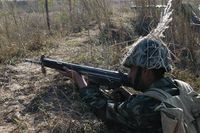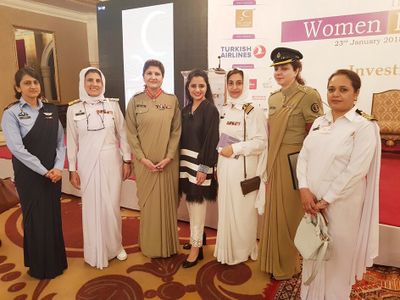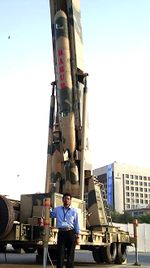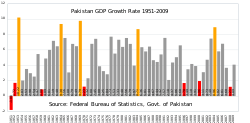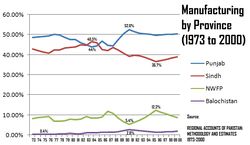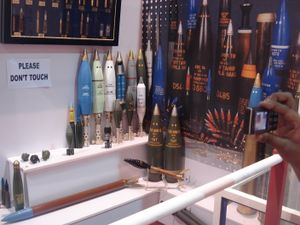القوات المسلحة الپاكستانية
| Pakistan Armed Forces | |
|---|---|
| پاک مسلح افواج | |
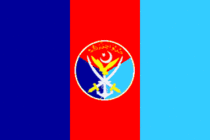 Tri-service Flag of Pakistan Armed Forces | |
| تأسس | 1947 |
| فروع الخدمة | |
| المقر الرئيسي | قيادة الأركان، روالپندي |
| القيادة | |
| القائد الأعلى | الرئيس ممنون حسين |
| وزير الدفاع | خواجة آصف |
| رئيس الأركان | الجنرال زبير محمود حياة الجيش الپاكستاني |
| العديد | |
| سن التجنيد | 16–49 سنة |
| التجنيد | None |
| الأفراد النشطون | 643,800 (6th ذوي الرتب) |
| أفراد الاحتياط | 513,000 |
| النفقات | |
| الميزانية | $8.7 مليار دولار (2017–18) (بترتيب 23) |
| النسبة من ن.م.ا. | 2.9% (2017) |
| الصناعة | |
| الموردون المحليون |
|
| الموردون الأجانب | |
| مقالات ذات صلة | |
| التاريخ | |
| الرتب | Awards and decorations of the Pakistan Armed Forces |
The Pakistan Armed Forces (أردو: پاک مُسَلّح افواج, Musallah Afwaj-e-Pakistan) are the military forces of Pakistan. They are the sixth largest in the world in terms of active military personnel and the largest among Muslim countries. The armed forces comprise three main service branches – Army, Navy, and Air Force – together with a number of paramilitary forces and the Strategic Plans Division Force.[1] Chain of command of the military is organized under the Chairman of Joint Chiefs of Staff Committee (JCSC) alongside chiefs of staff of the army, navy, and air force.[1] All of the branches work together during operations and joint missions under the Joint Staff Headquarters (JS HQ).[1]
Since the 1963 Sino-Pakistan Agreement, the military has had close military relations with China, working jointly to develop the JF-17, the K-8, and other weapons systems. اعتبارا من 2013[تحديث] China was the second-largest foreign supplier of military equipment to Pakistan.[2] Both nations also cooperate on development of nuclear and space technology programs.[3][4][5] Their armies have a schedule for organizing joint military exercises.[6] The military also maintains close relations with the United States, which gave Pakistan major non-NATO ally status in 2004. Pakistan gets the bulk of its military equipment from local domestic suppliers, China, and the United States.[2]
The armed forces were formed in 1947 when Pakistan became independent from the British Empire.[7] Since then, the armed forces have played a decisive role in the modern history of Pakistan, fighting major wars with India in 1947, 1965 and 1971, and on several occasions seizing control of the civilian government to restore order in the country.[7] The need for border management led to the creation of paramilitary forces to deal with civil unrest in the North-West and security of border areas in Punjab and Sindh by paramilitary troops. In 2016, the military had approximately 617,000 personnel on active duty, with 513,000 in the reserves, 402,000 in the paramilitary forces, and approximately 20,000 serving in the Strategic Plans Division Forces, giving a total of almost 1,500,000 soldiers.[8] The armed forces have a large pool of volunteers so conscription has never been needed, though the Pakistani constitution and supplementary legislation allow for conscription in a state of war.[9]
The Pakistan Armed Forces are the best-organized institution in Pakistan, and are highly respected in civil society.[10] Since the founding of Pakistan, the military has played a key role in holding the state together, promoting a feeling of nationhood and providing a bastion of selfless service.[11] In addition, the Pakistan Armed Forces are the largest contributors to United Nations peacekeeping efforts, with more than 10,000 personnel deployed overseas in 2007.[12] Other foreign deployments have consisted of Pakistani military personnel serving as military advisers in African and Arab countries. The Pakistani military has maintained combat divisions and brigade-strength presences in some of the Arab countries during the Arab–Israeli Wars, aided the Coalition forces in the first Gulf War, and took part in the Somalian and Bosnian conflicts.
التاريخ
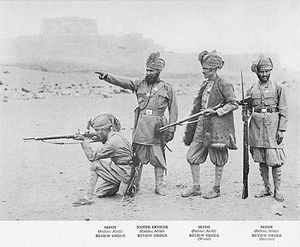
Current deployments
Within Pakistan
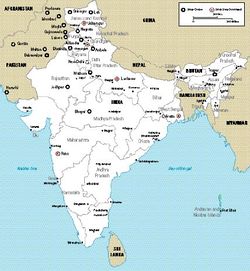
التنظيم وهيكل القيادة
رؤساء الأركان
العديد
| Service | Total active-duty personnel[8] | Total reserve[8] |
|---|---|---|
| Army | 550,000 | 500,000 |
| Navy | 22,000 | 5,000 |
| Air Force | 45,000 | 8,000 |
| Paramilitary Forces | 420,000 | 0 |
| SPD Force | 21,000[13][14] | 0 |
الزي الرسمي
أسلحة الدمار الشامل
Pakistan's development of nuclear weapons began in 1972, following the Indo-Pakistani War of 1971, with the government adopting a policy of deliberate ambiguity which was practiced and observed from 1972 to 1998.[بحاجة لمصدر] Amid pressure built after India's nuclear test in 1998, Pakistan successfully conducted its first publicly announced nuclear tests in 1998: Chagai-I and Chagai-II.[15] With these tests, Pakistan became the seventh nation to achieve the status of a nuclear power.[16]
دورة المخابرات الحربية
Inter-Services Intelligence (ISI) is the premier intelligence service of Pakistan that is responsible for providing, managing, and coordinating military intelligence for the Pakistan Armed Forces.[15] After an eminent intelligence failure in the Indo-Pakistani War of 1947, the ISI was established by Army Major-General R. Cawthome and Navy Commander S.M. Ahsan, in a view to coordinate military intelligence from each major service branch and provide an inter-service intelligence estimate.[17] While intelligence operatives are recruited from each service, including civilians, the ISI has become very powerful and influential.[15] Due to its wide range of intelligence operations and influence, the ISI has been criticized both internally and externally. The Director General for Inter-Services Intelligence is the head of the ISI and also the principal adviser to the Prime Minister and President of Pakistan; the ISI reports directly to the prime minister.[بحاجة لمصدر]
The Directorate of Military Intelligence (MI) provides intelligence to the Army, while the other main branches are served by Naval Intelligence and Air Intelligence. The intelligence services in each branch are tasked with providing intelligence on foreign operations, performing counterintelligence operations, and identifying and eliminating sleeper cells, foreign agents and other anti-Pakistani elements within Pakistan.[بحاجة لمصدر] Additional functions involve monitoring high-level military and political leaders and safe-guarding critical military and non-military facilities.[بحاجة لمصدر] The director-generals of each intelligence branch are usually two-star officers.[بحاجة لمصدر]
Traditionally, the bulk of intelligence work and efforts in Pakistan has been carried out by the ISI, the Intelligence Bureau (IB), and the Federal Investigation Agency (FIA) as well as the others in the Pakistani intelligence community.[بحاجة لمصدر] To provide better coordination and eliminate competition, the National Intelligence Directorate (NID) was established in 2014.[18] The NID serves a similar purpose as the U.S. National Intelligence Estimate, providing statistical analysis and counter-insurgency recommendations at all levels of command.[19]
الصناعات الحربية
الميزانية
الصناعات الحربية
مرئيات
| الجنرال ساحر شمشاد ميرزا يتولى مهام منصبه الجديد كقائد لهيئة الأركان المشتركة (27-11-2022) |
انظر أيضاً
- Pakistan Air Force
- Pakistan Army
- Pakistan Navy
- Pakistan Marines
- National Security Council (Pakistan)
- Paramilitary forces of Pakistan
- Pakistan and weapons of mass destruction
- Defence Science and Technology Organization
- Pakistan Armed Forces deployments
- List of missiles
- Space Research Commission
- Presidency armies
- British Indian Army
- Military exercises of Pakistan
- Pakistan–United States military relations
- NATO–Pakistan relations
- China–Pakistan military relations
- Defence industry of Pakistan
- Islamic Military Alliance
المراجع
- ^ أ ب ت Blood, Peter R. (1995). Pakistan. Washington D.C.: Diane Publishing Co. ISBN 0788136313. Retrieved 4 December 2014.
- ^ أ ب Doyle, Rodger (1998). "Arms trade". Scientific American. Sipri. 279 (5): 29. Bibcode:1998SciAm.279a..29D. doi:10.1038/scientificamerican0798-29. PMID 9796545.
{{cite journal}}:|chapter=ignored (help) - ^ "News". UK: BBC. 17 June 2010.
- ^ "World". News. CBS. 16 October 2008.
- ^ "South Asia". Asia Times.
- ^ "Al-Khalid MBT-2000/Type 2000 Main Battle Tank". GlobalSecurity.org. Retrieved 16 July 2010.
- ^ أ ب Singh, R.S.N. (2008). The military factor in Pakistan. New Delhi: Frankfort, IL. ISBN 0981537898.
- ^ أ ب ت The Military Balance 2010, p. 367, International Institute for Strategic Studies (London, 2010).
- ^ "Pakistan". UNHCR. Archived from the original on 19 يناير 2012.
{{cite web}}: Unknown parameter|deadurl=ignored (|url-status=suggested) (help) - ^ https://web.archive.org/web/20100620131859/http://gmfus.org/publications/article.cfm?id=357
- ^ Pakistan Army. Globalsecurity.org. Retrieved 12 July 2013, Switched to backup 27 January 2017.
- ^ "Monthly Summary of Contributors to UN Peacekeeping Operations" (PDF). Archived from the original (PDF) on 27 March 2009. Retrieved 20 April 2007.
{{cite web}}:|first=missing|last=(help); Unknown parameter|dead-url=ignored (|url-status=suggested) (help) - ^ Monthly Hilal English – Pakistan Armed Forces' Magazine, January 2013, pp 40, http://www.ispr.gov.pk/front/main.asp?o=t-hilal
- ^ 900 SPD soldiers pass graduation from Abbotabad centers, 20 April 2012, CNBC Pakistan, "Archived copy". Archived from the original on 15 أكتوبر 2012. Retrieved 6 يناير 2013.
{{cite web}}: Unknown parameter|deadurl=ignored (|url-status=suggested) (help)CS1 maint: archived copy as title (link) - ^ أ ب ت خطأ استشهاد: وسم
<ref>غير صحيح؛ لا نص تم توفيره للمراجع المسماةNew York University Press - ^ Riedel, Bruce (2013). Avoiding Armageddon : America, India, and Pakistan to the brink and back. Washington D.C .: Brookings Institution Press, Riedel. ISBN 081572408X.
- ^ Tomsen, Peter (2011). The wars of Afghanistan messianic terrorism, tribal conflicts, and the failures of great powers. New York, NY: PublicAffairs. ISBN 1610394127.
- ^ GEO News, 2014 (18 March 2014). "PM approves formation of National Intelligence Directorate, Rapid Response Force". GEO NEws, 2014. GEO NEws, 2014. Retrieved 8 December 2014.
{{cite news}}: CS1 maint: numeric names: authors list (link) - ^ Dawn.com (18 March 2014). "THe NID is established by PM Sharif". Dawn Newspapers, 18 March. Dawn Newspapers, 18 March. Retrieved 8 December 2014.
للاستزادة
- Shah, Aqil (2014). The Army and Democracy: Military Politics in Pakistan. Cambridge, MA: Harvard University Press. ISBN 978-0-674-72893-6.
- Ayub, Muhammad (2005). An army, Its Role and Rule: A History of the Pakistan Army from Independence to Kargil, 1947–1999. RoseDog Books. ISBN 9780805995947.
وصلات خارجية
- Ministry of Defence of Pakistan
- Pakistan Army
- Pakistan Navy
- Pakistan Air Force
- Pakistan Military Guide from GlobalSecurity.org
- BBC Pakistan Military Through the Ages
- CS1 errors: chapter ignored
- CS1 errors: unsupported parameter
- CS1 errors: missing name
- CS1 maint: numeric names: authors list
- Articles containing أردو-language text
- Pages using Lang-xx templates
- جميع المقالات التي فيها عبارات متقادمة
- Articles with unsourced statements from October 2015
- Articles with hatnote templates targeting a nonexistent page
- Pages with empty portal template
- 1947 establishments in Pakistan
- Military of Pakistan
- Pakistan federal departments and agencies


